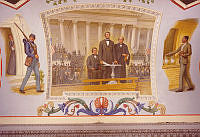Rubenstein Center Scholarship
Philip Reed
Enslaved Artisan in the President's Neighborhood
This article is part of the Slavery in the President’s Neighborhood initiative. Explore the Timeline
Often, the accomplishments and contributions of enslaved people are lost to history—undocumented, ignored, or forgotten by successive generations. One of these overlooked historic figures is Philip Reed, an enslaved man who worked as a sculptor’s apprentice.1 He contributed to a number of iconic sculptures, including the Statue of Freedom atop the U.S. Capitol Dome and the equestrian statue of Andrew Jackson in Lafayette Park.
Philip Reed was born into slavery in South Carolina around 1820. Clark Mills, a local sculptor, purchased Reed for $700 in Charleston, “when he was quite a youth.”2 According to later emancipation documents, Mills purchased Reed “because of his evident talent for the business.”3

1854 engraving of Clark Mills
Library of CongressIt is not surprising that Reed’s origin story centers around Charleston, South Carolina. At the time, the city had a large enslaved population, many of whom were artisans or craftsmen. According to art historian Daniel Kurt Ackermann:
More Charleston, South Carolina, craftsmen owned slaves (1,767)—and more identified enslaved craftsmen worked in Charleston (737)—than in any other city. Enslaved craftsmen were so ubiquitous in that city that local journeymen and apprentices lobbied fiercely for laws to regulate the training and conduct of their enslaved competitors.4
The experience of an enslaved craftsman was different from that of an enslaved agricultural or domestic laborer, and there were a few ways that apprenticeship was more desirable than agricultural labor. First, enslaved craftsmen in South Carolina and elsewhere generally had more freedom of movement. Some shopped for materials at local markets, while others traveled with their owners to other cities and states to work (including Philip Reed), or were hired out to work at the homes of wealthy planters.5 These experiences broadened the worldview of enslaved workers, allowing them to meet other enslaved people as well as members of free Black communities. Some enslaved artisans also had access to tools and additional income, both of which could be used to pursue and purchase freedom.6 Despite these advantages, enslaved craftsmen like Philip Reed still experienced the innumerable hardships of a life in bondage.
Little information about Philip Reed’s life in South Carolina exists, but it is likely he lived at Clark Mills’s residence and studio at 51 Broad Street in Charleston.7 Mills did not teach Reed to read or write; instead, he trained him in the art of sculpting, plastering, and basic engineering.8 Mills himself was also a self-taught artisan. Reed likely aided Mills in the creation of marble busts and other plaster works.
Moving to the President’s Neighborhood
In 1845, following the death of former President Andrew Jackson, the Jackson Monument Committee began planning for the design and erection of a memorial to “Old Hickory” in Washington, D.C.9 Clark Mills submitted a design to the committee, and received the commission in 1848.10 The equestrian statue would be placed in Lafayette Park just north of the White House. Mills moved to Washington, D.C. to construct the statue and brought Philip Reed with him. Click here to learn more about the enslaved households of President Andrew Jackson.
Mills set up a temporary foundry at 15th Street and Pennsylvania Avenue near the Treasury Building, adjacent to the White House Grounds.11 His design for the statue was incredibly ambitious, and would become the first bronze statue in America, as well as the “first equestrian statue in the world to be balanced solely on the horse’s hind legs.”12 He taught himself—and Reed—the art of metalworking in order to create the bronze monument.13

Philip Reed assisted in the casting of the Jackson Statue, pictured here in 1853.
The White HouseThere is no documentation of Reed’s explicit role in the creation of the statue. He may have contributed to the design, but it is most likely that Reed was tasked with maintaining the foundry fires and assisting in the casting of the bronze. The fifteen-ton statue was finished in 1852 and dedicated in Lafayette Park on January 8, 1853—the thirty-eighth anniversary of the Battle of New Orleans. The bronze statue, situated atop a marble pedestal, depicts Andrew Jackson in full military dress riding his horse, Duke. Senator Stephen A. Douglas of Illinois praised Mills’s bronze statue, calling it “the work of inborn genius;” Philip Reed’s contributions went unmentioned, and he likely did not receive an invitation to the ceremony.14

Clark Mills's studio on Bladensburg Road
Library of CongressAfter finishing the Jackson sculpture, Mills was commissioned to create an equestrian statue of George Washington, located in present-day Washington Circle. Reed likely assisted in this statue’s casting at Mills’s temporary foundry built adjacent to the White House. The statue was dedicated in 1860. During this period, Mills also purchased land on Bladensburg Road in Maryland, near the city limits of Washington, D.C.; he had a permanent home and octagon-shaped studio built there.
Thanks to these prominent works, Clark Mills became a well-known sculptor in antebellum Washington, D.C., which provided an increased income with which to purchase additional enslaved servants.15 By 1860, Clark Mills owned eleven enslaved men, women, and children: Lettie Howard, Tilly, Tom, Ellick, Jackson, George, Emily, Levi Thomas, Rachel Thomas, Ann Ross, and Philip Reed.16
The Statue of Freedom
That year, Mills took on another important commission: the casting of the Statue of Freedom, which would top the dome of the U.S. Capitol.17 The history of the Capitol Building cannot be separated from slavery, as its construction relied on the exploitation of hundreds of enslaved laborers, many of whom were also hired out to build the White House.18 Philip Reed is one of the best documented enslaved individuals who worked on this project, and he appears to be the only enslaved laborer owned by Mills to work in the foundry. A payroll document in the Architect of the Capitol’s collections shows that Reed worked alongside free blacksmiths, finishers, and stucco workers at Mills’s foundry to cast the Statue of Freedom, which was designed by artist Thomas Crawford.
Reed “was paid at $1.25 per day” for keeping the fires beneath the casts, which was “higher than the other laborers who received $1 a day.”19 However, he was only allowed to keep wages earned on his day off, Sunday, while Mills claimed Reed’s wages for the remainder of the week.20 It was not uncommon for slave owners to claim the wages of their laborers, underscoring their control over all aspects of their enslaved workers’ lives.21

Reed and the other workers at Mills's foundry cast the bronze Statue of Freedom from this plaster model. It is currently on display at the U.S. Capitol Visitor Center.
Library of CongressPhilip Reed was integral to the casting process of the massive nineteen-foot, six-inch Statue of Freedom. When a 15,000-pound plaster cast of the figure was shipped from Italy to the United States, it arrived in many pieces; these were assembled and displayed at the Capitol prior to being moved to Mills’s Maryland foundry for casting in bronze.22
The massive State of Freedom also had allegorical significance. The classical, toga-wearing woman harkens to the ancient democratic ideals that underpin America’s government. Original designs also proposed that Freedom wear a “liberty cap.” In Ancient Greece and Rome, this red hat was worn by freed slaves.23 Throughout history, the cap came to symbolize freedom and was commonly worn during the French Revolution. However, Secretary of War and later President of the Confederate States of America, Jefferson Davis, objected to the use of the “liberty cap” on the sculpture due to its association with slavery and emancipation.24 Thomas Crawford instead designed a helmet for Freedom, which represents her protection of the nation.
Moreover, the irony of an enslaved man working on the Statue of Freedom was not lost on Americans; a New York Tribune reporter writing on the construction project noted: “Was there a prophecy in that moment when the slave became the artist, and with rare poetic justice, reconstructed the beautiful symbol of freedom for America?”25

This is an excerpt from Clark Mills's petition to receive compensation for his eleven emancipated enslaved servants. Reed is listed at the bottom. You can see that Mills requested far more compensation for Reed, proving his lucrative workmanship in the eyes of his owner.
National Archives and Records AdministrationOn April 16, 1862, slavery was abolished in Washington, D.C., and on June 20, 1862, Clark Mills petitioned for compensation under the DC Compensated Emancipation Act. In exchange for payment from the federal government, Mills freed Reed and the ten other enslaved people in his household.26 Reed was forty-two years old at the time. On December 2, 1863, the Statue of Freedom was unveiled atop the Capitol Dome—a testament to Reed’s work and an evocative symbol of the freedom that he could finally experience.27
Post-emancipation, Philip Reed remained in Washington, D.C. and established a successful career as a free plasterer. He married twice; first, to a housekeeper named Jane, with whom he had a son named Henry Reed c. 1868, and later to laundress Mary Marshall, whom he married in 1879.28 He lived and worked just off of the National Mall on 3rd and C St. SW until his death on February 6, 1892.29
Unfortunately, even in death, Reed experienced racial injustice, and his body was disinterred twice after being laid to rest. His first burial site, Graceland Cemetery, closed in 1894, and Reed’s gravesite was subsequently moved to an historically Black cemetery, Columbian Harmony Cemetery, in northeast Washington, D.C. His burial site was later exhumed in 1960 (alongside approximately 37,000 other African-American graves) for the construction of the Rhode Island Ave-Brentwood Metro station.30 Many prominent Black Washingtonians, including Mary Todd Lincoln’s White House seamstress, Elizabeth Keckly, and Paul Jennings, an enslaved servant who worked in the Madison White House, were buried in the cemetery. The graves were relocated to National Harmony Memorial Park in Landover, Maryland. A memorial plaque within the cemetery honors Reed.31
Recognition of Reed’s life and work is a relatively recent development. Sixty-five years after the Statue of Freedom was unveiled, Tennessee Representative Finis J. Garrett read a poem and paper by civil servant William A. Cox about the Statue of Freedom before the United States House of Representatives:
the facts are that… [the Statue of Freedom’s] successful taking apart and handling in parts as a model was due to the faithful service and genius of an intelligent negro in Washington named Philip Reed, a mulatto slave owned by Mr. Clark Mill (sp.), and that much credit is due him for his faithful and intelligent services rendered in modeling and casting America’s superb Statue of Freedom.32
Still, further research about Reed’s life and legacy did not surface until the early twenty-first century. Today, his contribution to the United States Capitol Dome is recognized in the Capitol Visitor Center’s Emancipation Hall, alongside the many unnamed enslaved laborers who constructed the building. The plaster cast of the Statue of Freedom is also on display there.





